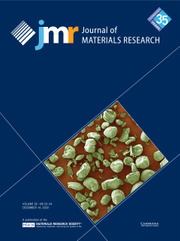Crossref Citations
This article has been cited by the following publications. This list is generated based on data provided by Crossref.
Wakiya, Naoki
Chun, Sung-Yong
Lee, Chae Hyun
Sakurai, Osamu
Shinozaki, Kazuo
and
Mizutani, Nobuyasu
1999.
Effect of Liquid Phase and Vaporization on the Formation of Microstructure of Pr Doped ZnO Varistor.
Journal of Electroceramics,
Vol. 4,
Issue. S1,
p.
15.
Daneu, Nina
Novak Gramc, Nives
Rečnik, Aleksander
Maček Kržmanc, Marjeta
and
Bernik, Slavko
2013.
Shock-sintering of low-voltage ZnO-based varistor ceramics with Bi4Ti3O12 additions.
Journal of the European Ceramic Society,
Vol. 33,
Issue. 2,
p.
335.

